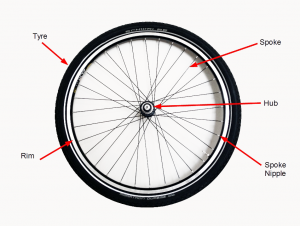Your choice of wheels is limited to two general categories: factory-made and hand-made. Factory-made wheels are much cheaper, but are more prone to problems because the spokes aren’t individually set and the materials tend to be of a lower quality in mass produced lines. A hand-made wheel, from a reputable builder, will give you a wheel with good all-round tensioning of the spokes and the opportunity to select wheel components to meet your specific needs and budget.
Rim – you will be looking for a rim with a higher number of spoke holes. When looking at rims they will often be described as “32h” or “36h” etc. This number relates to the number of spoke holes in the rim. The more holes the merrier as more spokes make for a stronger wheel, which is exactly what you want. The rim will also be the braking surface if you choose to go with caliper or V-brakes.
Spokes – robust spokes are important. Spokes need to be correctly tensioned to reduce the likelihood that they or the rim will break. The most common thing to break on a wheel is the spokes. Unless you want to bend the rim, you shouldn’t ride your bike with a broken spoke, making them a more important piece of equipment than you might have first thought.
Hub – each time your wheel turns, the bearings and other parts of the hub are at work. When selecting a hub you need to consider the quality of the bearings, whether the unit is properly sealed against dust and grit which will cause damage to the bearings, and if you want to be able to service the hub yourself on the road. If you want to be able to pull the hub apart to regrease or replace bearings, you will need one that comes apart and you’ll need the right tools for the job. The hub will also house the disc should you decide to go with disc brakes over caliper or V-brakes.
Wheel size
This is essentially a personal preference, but consideration should be given to the availability of replacement wheels and tyres in less developed countries or remote areas if you plan to tour there.
Wheel sizes (generalised standards):
- 700c wheels are standard on road bikes
- 26″ wheels are standard on mountain bikes
- 20″ wheels are the standard on BMX bikes
- 29″ wheels are a new addition for mountain and cyclocross bikes
While the availability of tubes and touring tyres for 700c wheels is improving, there are still reports of cyclists not being able to source spares in less developed countries. The 26″ wheel is in more common use in less developed countries, meaning that spare tubes and tyres should be more readily available
Consider where you would like to tour on your bike, over it’s whole lifetime, and let that inform your decision about what size wheels to install.
Compatibility
- Wheel size will impact on frame selection, as the frame will be made to accomodate the wheels and braking system (as per hub selection).
- The rim and hub setup of your wheels must be compatible with the braking system you select (ie. disc or rim brakes).
- Tyre and wheel size affect the ability to install mudguards, make sure you have enough clearance between the frame and the tyre.
Next page: Gears & Brakes
Is our information useful????
This website has been created to support our fundraising efforts for research into a cure for Melanoma. If you found this information useful, please consider making a small donation.
